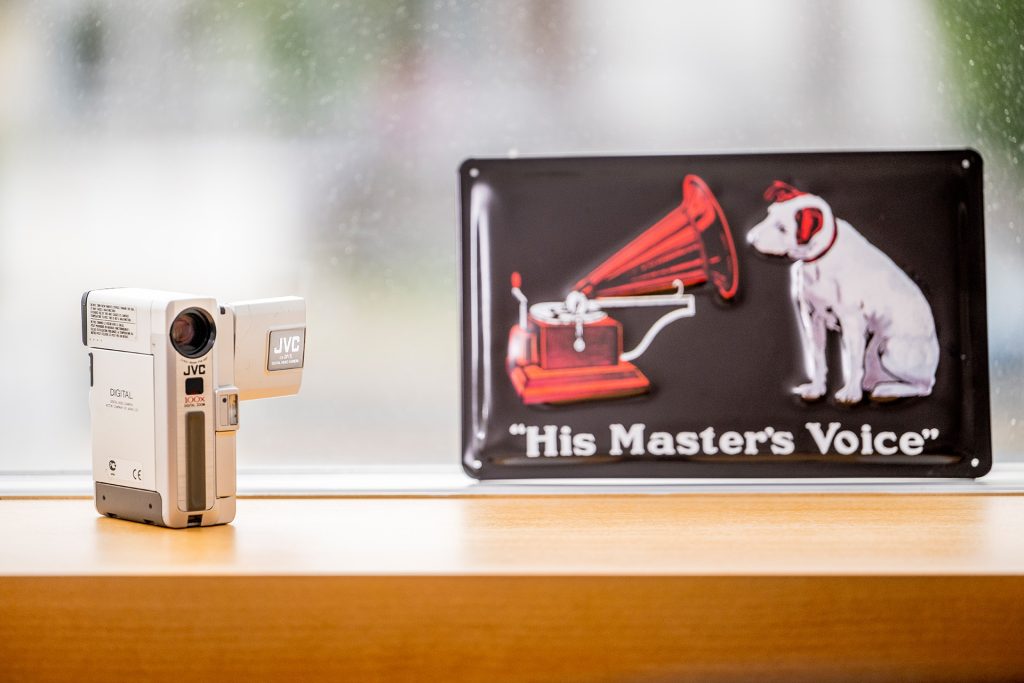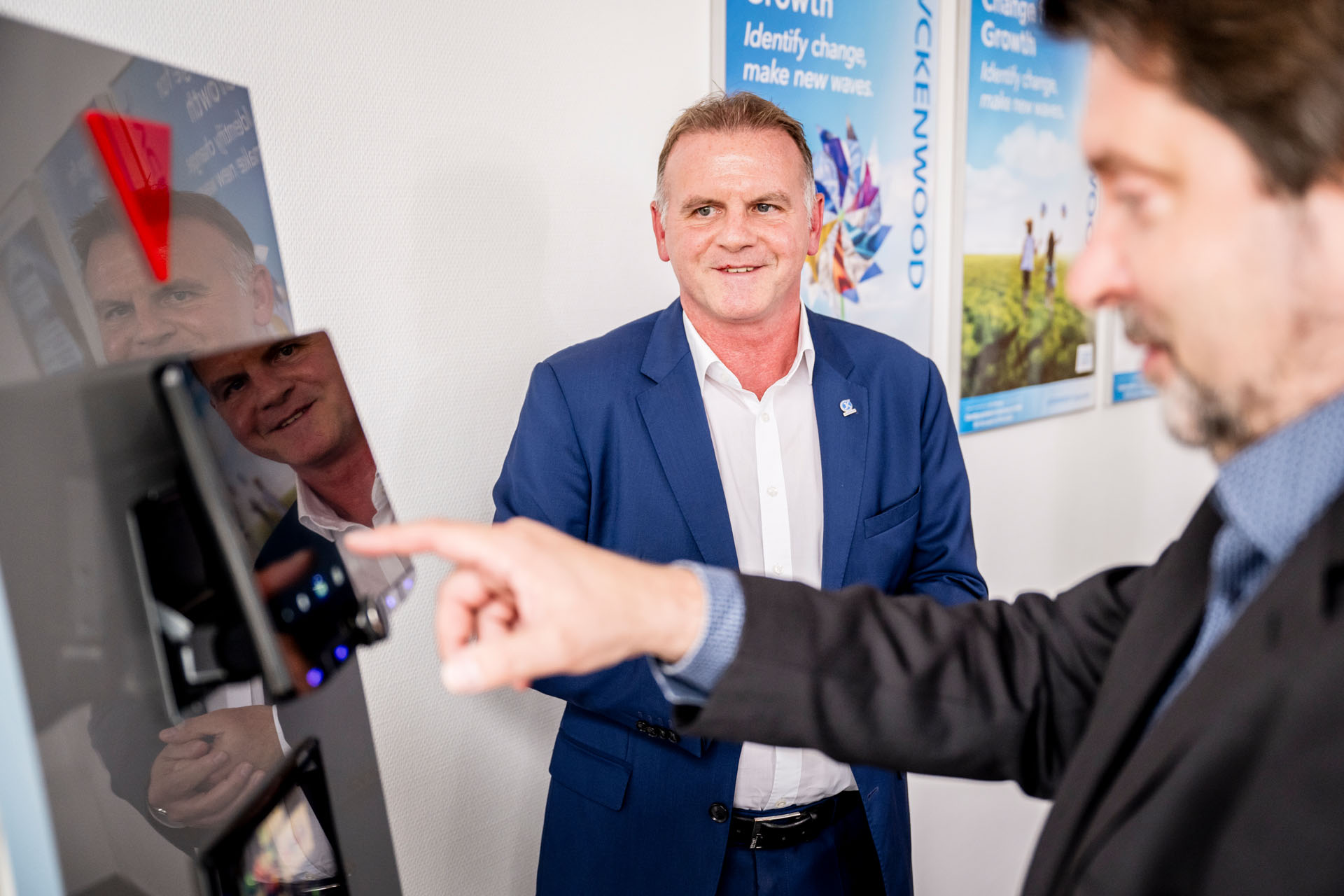In the 80s, nobody could get past the JVC VHS system, and hardly any stereo system could do without Kenwood components. The two formerly independent Japanese brands now operate as the joint company JVCKENWOOD, which offers car and home electronics, wireless systems for the global consumer electronics market, professional broadcasting, CCTV as well as digital and analog radio devices and systems. J-BIG spoke to Thorsten Godulla, Managing Director of the German subsidiary, to find out what challenges JVC and Kenwood have faced in the past, how the merger came about a few years ago and also how Kenwood outsmarted car radio thieves.
J-BIG: Let’s talk about the origins first: How did the first of the two brands – JVC – develop?
Thorsten Godulla: The JVC brand origins are in the USA and was founded in 1927 under the name Victor Company, as a subsidiary of the US company Victor Talking Machine Company (VTMC). In 1940, the Victor Company became independent with its slogan “His Masters Voice” and separated from the parent company. As a result, the company began to promote the record business in Japan. In this context, it is interesting to note that the Victor brand launched the first TV receiver in Japan as early as 1939. In 1954, Matsushita Electric Industrial (now Panasonic Corporation) took over the company, which had since been renamed JVC, which stands for Japan Victor Company.

J-BIG: How did the takeover by Matsushita affect JVC?
Thorsten Godulla: The takeover was followed by the global expansion of the JVC brand, which experienced a veritable explosion in growth with the development of VHS technology in the video sector. In the 80s, this was actually quite comparable to the spread of the smartphone today. Consumers were able to record films themselves and then watch them on a playback device. That was a world first. Consequently, JVC developed camcorders, which shaped the brand for decades.


J-BIG: Tell us more about the development of VHS.
Thorsten Godulla: The VHS video recording and playback system developed by JVC first appeared on the Japanese market in 1976. It competed with Phillips VCR and Sony’s Betamax picture recording systems. It was able to prevail over the competition thanks to generous licensing. Where the competition limited its partners through restrictive licensing, JVC distributed its VHS licenses generously and thus opened up the market. To prevail over established formats and create a new standard was a great success story.
The camcorder business emerged at the same time. We manufactured very innovative products in this area and clearly became the market leader. Even a brand like Sony found it very difficult to compete with us back then.
J-BIG: Let’s talk about the beginnings of Kenwood. How did it all start with the second brand?
Thorsten Godulla: Kenwood started in 1946 in Japan as Kasuga Radio Co. Limited, which made a name for itself with shortwave technology. In 1955, for example, they launched the first short-wave receiver on the Japanese market. In 1960, the decision was made to turn Kasuga into Trio Kenwood in the US market and Trio Corporation in the Japanese market. The “Trio” in the company name refers to the three company founders from one family, Hisao Kasuga, Nakakazu Kasuga and Jiro Kasuga.
Only a few years later, in 1963, the world’s first foreign branch was established in California. The first German branch was opened in 1969 in the Rhine-Main area, in Heusenstamm to be precise.

J-BIG: And how did the Kenwood brand continue to develop? Which products were sold in Germany?
Thorsten Godulla: Single components for stereo systems such as tuners or receivers were the start of the Kenwood brand within the hi-fi market. This continued to develop over the years until the big hi-fi boom at the end of the 1970s. In the mid-90s, there was a major trend towards smaller compact systems, which the Kenwood brand eventually joined. Looking back, it was a necessary but also difficult decision to enter this mass market, which triggered many changes within the company. After all, the company was competing with strong brands such as Aiwa and Sony, which dominated the market.
Almost parallel to this development, starting in the 90s, Kenwood pushed the car audio segment forward. A very successful product of the Kenwood brand at the time was the MASK car radio. Some of you may remember that many radios used to be stolen from cars. As a result, we developed a product with a cover that was lowered so that it looked as if there was no car radio installed at all.
Another big topic at the time was the so-called changer packages, which made it possible to play several CDs in the vehicle. The JVC and Kenwood brands were already incredibly strong in this segment, if not the market leader in Germany together with Pioneer and Panasonic. This led to the development of a second pillar in the automotive sector alongside classic hi-fi.
The MASK CD changer system for 1299 German marks sold like hotcakes at the time. Our first MP3 player, the KDC6090 MP, was the breakthrough for MP3 in the car. As a result, we finally established ourselves in the car audio segment in addition to the home hi-fi sector.

J-BIG: Kenwood was without doubt a household name when it came to car radios in the 90s. What about JVC, who were also competing in this segment at the time? How did JVC further develop into the 2000s?
Thorsten Godulla: JVC’s start in Europe was in the UK. JVC Europe was founded there in 1973 as the headquarters for Europe followed by the establishment of the German subsidiary in Friedberg in 1978. Over the years, the brand has grown within Germany and established itself in the TV sector and very strongly in the car audio segment.
Unlike Kenwood, however, we still had the visual sector at JVC. I would divide this into two segments. Firstly, there is the video segment, where a lot has changed due to the advent of the smartphone. Secondly, I see the TV segment. The Japanese were unable or unwilling to keep up with price developments in the mass market and were caught off guard by the Koreans, with Samsung and LG, using incredibly aggressive market positioning. Unfortunately for JVC, they simply could no longer find a suitable positioning in this sector. They were simply too expensive. At the same time, the camcorder market collapsed, which is now nothing more than a niche market.
And I have already mentioned it: there have been major changes in the market that have affected both JVC and Kenwood. Let’s think of products like the iPhone, the iPod or services like iTunes, Napster etc. These developments changed the market forever.


J-BIG: JVC and Kenwood both had difficulties in the changing markets and eventually merged. How did this come about?
Thorsten Godulla: Let’s start with the name: The fact that JVCKENWOOD was now written in one word as the company name took some getting used to, even for us at first, but the decision to do so followed a logical approach. You have the two brands, you bring them together and since the “J” precedes the “K” in the alphabet, you decide on JVCKENWOOD and not the other way around.
How did this merger come about? The two companies had grown closer between 2000 and 2005 and finally decided to merge in Japan. The holding company was subsequently founded in 2007 and officially launched in 2008. The JVCKENWOOD Corporation was later formed in 2011. Matsushita had completely withdrawn at this point. Beforehand, negotiations were held and the whole project was prepared internationally. For example, we – I was working for Kenwood at the time – made contact with our colleagues in Friedberg at an early stage and exchanged ideas. As part of the merger, the number of branches was reduced, as it made little sense to work at two different locations in a compact market.
J-BIG: How has the sales structure and number of employees changed in the course of the merger? Perhaps compared to the 80s or 90s.
Thorsten Godulla: For Kenwood, there were around 30 sales colleagues in the German market at the peak of the business. For JVC, we probably had about twice that number.
Of course, this has changed due to market conditions. With Media Markt and Saturn, we simply experienced a streamlining of the classic specialist retail stores. Decentralized distribution was increasingly replaced by centralized distribution.
In other words, support for the traditional small hi-fi store around the corner disappeared and this development also led to changes in the local sales teams.

J-BIG: How many employees do you still have in Germany today?
Thorsten Godulla: We currently have 60 employees in Germany. Before the merger, there were about twice as many.
J-BIG: You have changed a lot as a company in recent years and realigned your focus. Which products do you focus on selling today?
Thorsten Godulla: We now offer so-called aftermarket products. In other words, car radios and multimedia systems that can be retrofitted. The basis is often formed by “double Din slots”, which are standard in the vehicles in which our products can be retrofitted. Generally speaking, these are Japanese vehicles. Audi, Mercedes, VW and other manufacturers do not enable any retrofitting options in this area. But our products still enjoy a strong following in the rapidly growing caravan business.
Perhaps this is interesting: In Japan, there is the so-called DOP sector, the dealer option business, in which the Kenwood brand is well represented. We work together with Garmin as a map platform in Europe and the USA, and in Japan with our own map system. We also supply the automotive industry in Japan, unlike German manufacturers who integrate their own systems into the vehicle ex-factory. So, car audio is still a big sector.
Another segment we haven’t even talked about yet is that of two-way radios. Short-wave technology was not only used in the audio and radio sector, but also in two-way radio. And in Japan, we as Kenwood are still a leading brand in the amateur two-way radio sector today.

J-BIG: Very interesting. How did you get into the two-way radio business?
Thorsten Godulla: We started with professional two-way radios in 1978, and we are still using these radios worldwide today. In the US market, for example, we have achieved a very strong position. If we compare the car audio and radio segments in the US, we see that the radio segment is almost as strong as the car audio segment. We are operating in an incredibly broad-based market environment over there and have the advantage of being able to market our products in the so-called “public safety market”.
Why is that worth mentioning? Because we have not been able to do so in Europe or Germany to date. Germany has its own radio standard for safety authorities in the form of digital Tetra technology. Unfortunately, however, we do not have any products that we can offer in this area.
And this is where we differ from the USA. There is a “P25” protocol that creates a different situation for us as a manufacturer, so that we are able to supply our devices to the security authorities in the US, which is not possible in Germany as we do not have Tetra technology.

J-BIG: Do you currently offer other products we haven’t talked about?
Thorsten Godulla: Yes. JVC still has the projector sector, for example. We may be talking about a niche market, but it does represent a significant image for the JVC brand. And the brand is also still a well-known name in the professional camcorder sector. At the same time, we are also involved in the headphones sector, although for historical reasons this is not as strong as our colleagues in other European countries such as the UK, France and Spain. In this segment, we also offer a wide range of products from wireless in-ear to classic on-ear headphones.

J-BIG: Where would you say JVCKENWOOD is at today?
Thorsten Godulla: The car audio segment is clearly the dominant market for both brands. Or to put it another way: we dominate this market. We have the largest combined market share, followed by Pioneer and Sony, who are also present in this segment.
J-BIG: And what is your strategy for the two brands in this segment?
Thorsten Godulla: Basically, it is not an easy task to operate with two strong brands in one market at the same time. I would say that from a historical perspective, we have managed this quite well. The JVC brand has become established in the car audio sector through a broad marketing strategy, which we continue to pursue today.
The Kenwood brand is more of an audiovisual brand that promises more entertainment in the car – i.e. multimedia and navigation as well as comprehensive smartphone integration. In the DACH markets, the positioning is clear: JVC is stronger in the car audio sector, Kenwood in the car entertainment sector. However, if we go to a country in Europe outside the DACH region, the situation looks somewhat different again.

J-BIG: We have now gained a lot of interesting insights into the history of both brands, the market and your current product portfolio. Could you give us a few more figures so that we can better understand the dimensions?
Thorsten Godulla: Of course. If we look at sales in the car audio segment in Germany, for example, we are talking about 40 percent of total German sales, which in figures means 50 million euros.
The two-way radio segment accounts for around 20 to 25 percent of turnover and we generate the rest with audio, professional camcorders and projectors. I would also like to add that we are a healthy company. And have been for years. The Group as a whole is also doing well. Its turnover is around two billion euros.


J-BIG: Since you just mentioned the Group as a whole. Would you say that the corporate culture and product philosophy are still characterized by the Japanese culture?
Thorsten Godulla: I would be lying if I said that the mentality in the company has changed by any means in terms of products. We always want to meet the highest standards. That is our philosophy. And we live by it. To be honest, this is sometimes difficult for us marketing and sales subsidiaries, because in the tough market environment it would sometimes be easier to compromise a little in order to remain competitive. But this is still not desired and is not practiced. Nevertheless, we are a very successful brand.
J-BIG: And what does the exchange with Japan look like? Are you fairly separated from the headquarters and more or less only receive the products or is there a more intensive exchange?
Thorsten Godulla: Well, we have two years of COVID-19 under our belt, which has changed a lot worldwide, but also in our company. Before the pandemic, we had various expats on site here in Germany. However, when the pandemic started, these employees were withdrawn, simply for safety reasons. Health before business and that’s the way it is in our company.
Today, we still have a Japanese colleague on site who is our interface. There are a few more Japanese colleagues in our European branch JVCKENWOOD Europe in Amsterdam – and this branch also acts as an interface to the headquarters in Japan.
It would certainly be valuable for our branch, but also for our company as a whole, to have one or two more Japanese colleagues located here. It’s just different when you have a colleague in the office and communication takes place face-to-face.
However, the exchange with Japan is generally good and also important in our subsidiary. Over the years, our Japanese colleagues have learned to listen more to local employees and we are also happy to provide input. Input that is listened to.

J-BIG: You have come closer over the years in terms of communication, you would say?
Thorsten Godulla: It’s a process and certainly not an easy one. As a European, it is often not easy to deal with Japanese corporate culture, I say that quite openly. To put it simply: Americans speak one language and communicate it directly. We in the EMEA economic region speak many languages and have different country-specific approaches. And this is still complex even after many years.

J-BIG: Finally: What will happen next in Germany? What are the plans? What can we expect?
Thorsten Godulla: The strategy for the next few years is currently a major topic for us in the Group. The management only recently communicated Vision 2025 to the outside world and the buzzword there is “Change for Growth”. Where are we going as a company with the three brands JVC, Kenwood and Victor? How do we position ourselves in our environment? That is also the big challenge for us here in Germany.
We receive the products from Japan but are now a little more independent in our marketing strategy. There are certain things that we work on independently here. For example, the area of home audio. We develop for and with our colleagues here in Germany as a mandate for the entire European market. And of course, we are proud of that. In addition, we need to continue to position and establish ourselves in the B2B business. And like many companies in Germany, we also have a relatively unbalanced age structure, are in a state of transformation and will have to change a few things. These are all challenges in the current market environment.
But what we as a company will always have in our favor is that we are a Japanese company. And Japanese companies stand for loyal cooperation and teamwork like no other. I think these are aspects that should not be underestimated.



